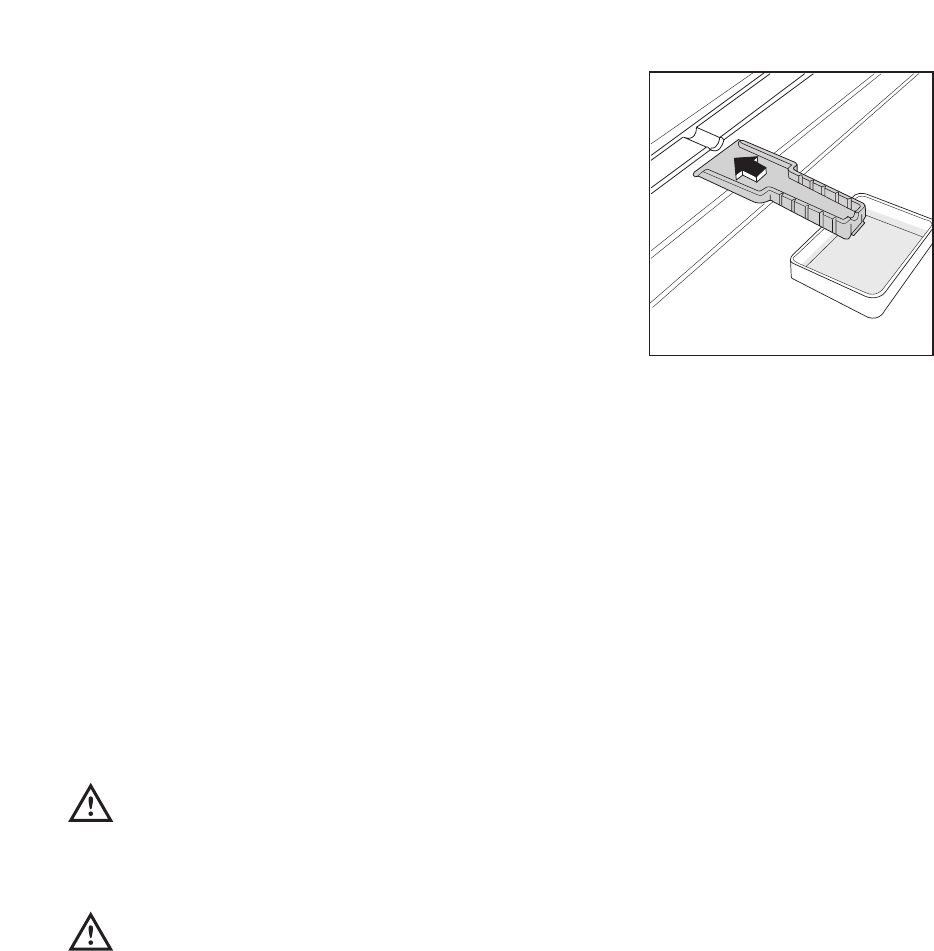
8
When the appliance is not in use
When the appliance is not in use for long periods,
disconnect from the electricity supply, empty all
foods and clean the appliance, leaving the doors ajar
to prevent unpleasant smells.
External cleaning
Wash the outer cabinet with warm soapy water. Do
NOT use abrasive products.
Once or twice a year dust the condenser (black grill)
and the compressor at the back of the appliance,
with a brush or vacuum cleaner, see figure.
You MUST ensure that the appliance is switched
OFF. An accumulation of dust will affect the
performance of the appliance and cause excessive
electricity consumption.
D273/1
CONDENSER
COMPRESSOR
MAINTENANCE AND CLEANING
Before any maintenance or cleaning work is
carried out, DISCONNECT the appliance from
the ELECTRICITY supply.
Internal cleaning
Clean the inside and accessories with warm water
and bicarbonate of soda (5ml to 0.5 litre of water).
Rinse and dry thoroughly.
NEVER USE DETERGENTS, ABRASIVE
POWDERS, HIGHLY PERFUMED
CLEANING PRODUCTS OR WAX
POLISHES, TO CLEAN THE INTERIOR AS
THESE WILL DAMAGE THE SURFACE AND
LEAVE A STRONG ODOUR.
9
Defrosting
When the frost has reached a thickness of up to
4mm it can be removed using the ice scraper
provided with the appliance. During this operation it
is not necessary to disconnect the appliance from
the mains and remove the food. Never use metal
tools for this operation.
For complete defrosting (once or twice a year)
proceed as follows:
- turn the thermostat (B) dial to the ÇOFFÈ position
(■) or disconnect the appliance from the mains.
- Remove any food from inside the freezer and
fridge, wrap it in several sheets of newspaper and
store in a cool,dry place.
- Leave the door open and insert the ice scraper
under the channel in the centre of the lower part
of the appliance; place a low-sided container
beneath the scraper to collect the water (see fig.).
- Clean and dry thoroughly.
- Replace the scraper in one of the drawers .
- Reconnect the appliance to the mains or reset
the thermostat to a functioning position.
- After letting the appliance run for at least two
hours in fast freeze mode, replace the previously
removed food into the compartment.
Important
A temperature rise of the frozen food packs, during
defrosting, may shorten their safe storage life.
Attention!
In the event of a power failure causing the
temperature within your freezer to rise, do not re-
freeze the food without checking its condition.
The following guidelines should assist you.
Ice-cream: once thawed should be discarded.
Fruits & Vegetables: if soft should be cooked and
used up.
Breads & Cakes: can be re-frozen without danger.
Shellfish: should be refrigerated and used up
quickly.
Cooked Dishes: i.e. casseroles should be
refrigerated and used up.
Large Pieces of Meat: can be re-frozen providing
there are still ice crystals remaining within them.
Small Joints: should be cooked and can then be re-
frozen as cooked dishes.
Chicken: should also be cooked and re-frozen as a
cooked dish.
D068


















